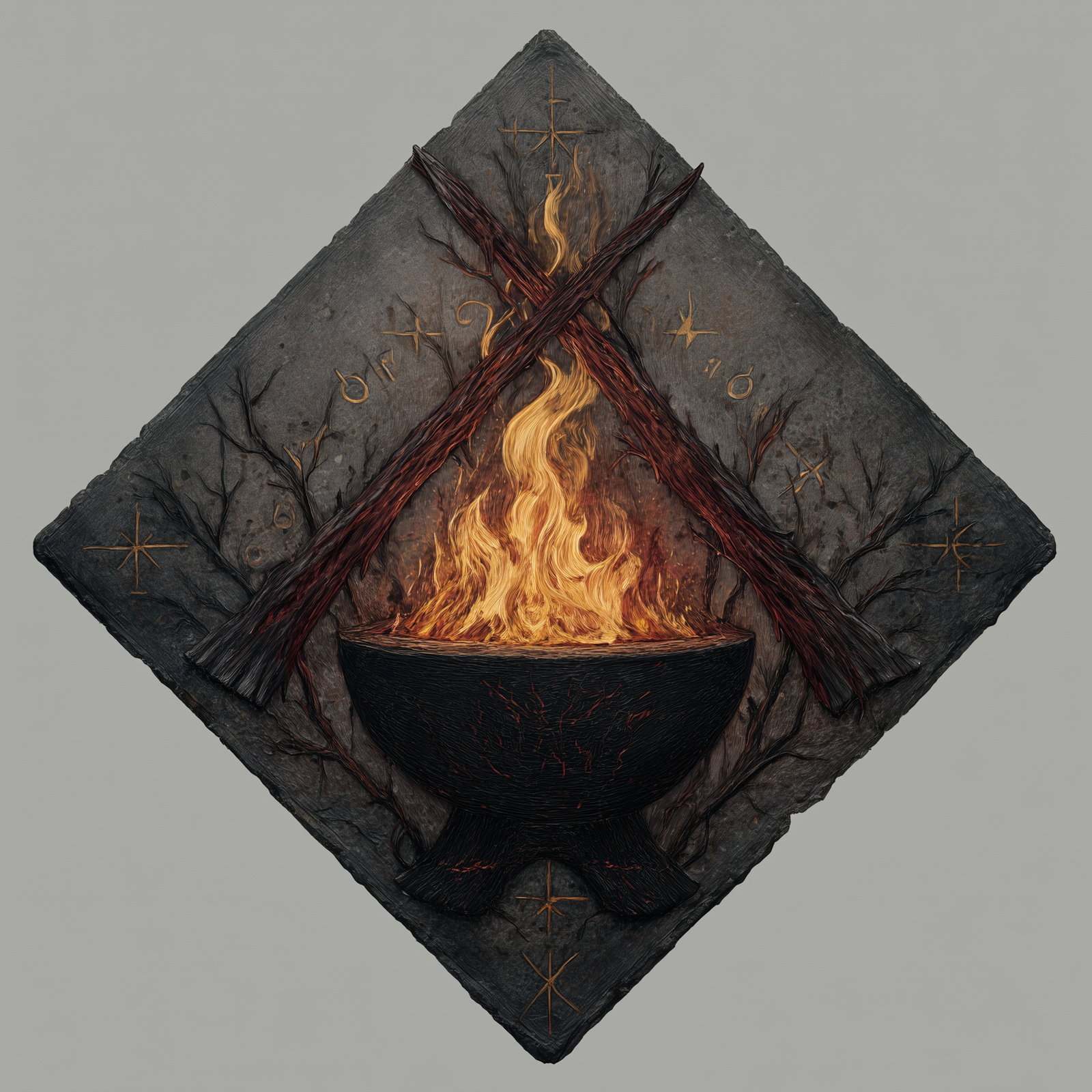Carbonari, “The Emberbound Brotherhood”
“Unmask the Carbonari: a secret brotherhood of fire-tenders, oaths, and rebellion—perfect fodder for conspiracies in your next campaign.”

- Name – The Carbonari, “The Brotherhood of Charcoal and Flame”
- Symbol / Emblem – A brazier of eternal fire crossed by two brands, often set upon a darkened shield of soot and ash.
- Motto or Slogan – Ex Cinere Lux (“From Ash, Light”).
- Type – Secret society and brotherhood of artisans, mystics, and rebels.
- General Alignment – Chaotic Good in intent, though viewed as Chaotic Neutral or even Evil by their enemies.
- Purpose / Function – To preserve hidden lore, oppose tyranny both mortal and supernatural, and guard the common folk from unseen threats that stalk the night. Outwardly they appear as a fellowship of charcoal burners and woodsmen.
- Founding Date / Origin – Said to have arisen in the shadowed forests of the Apennines during the time when Rome first fell to fire and sword, their lineage stretching back through wandering heretical monks and pagan fire-keepers.
- Founders – A circle of exiled mystics and charcoal burners, among them the legendary Fra Alberico, who claimed to bear a spark of Prometheus’ stolen flame.
- Beliefs & Core Values – The Fire of knowledge is the divine covenant: it reveals truth, purifies corruption, and wards off the monstrous. Brotherhood, secrecy, and defiance against unjust rulers are sacred duties.
- Public Reputation – Among peasants they are spoken of as protectors and dangerous charm-bearers in equal measure; among lords and clergy they are seen as conspirators, heretics, and fomenters of rebellion.
- Hidden Agenda (if any) – To preserve forbidden relics of fire and to prepare for a reckoning against both oppressive crowns and the ancient, inhuman powers that prey upon mankind.
- Leadership & Hierarchy – Governed in secret by the Grand Masters of the Flame. Beneath them are Fathers of the Furnace, each overseeing a region, and cells of brethren known as Kilns, with little knowledge of one another’s workings.
- Number of Members – Estimated in the low thousands, though no true count is known. Their scattered enclaves make them difficult to measure.
- Key Figures – Fra Alberico the Fire-Touched (founder, possibly immortal), Sister Fiore of Naples (healer and exorcist), Matteo “Ash-Hand” (rumored pact-bearer with the spirits of oak).
- Recruitment & Membership – They seek woodsmen, scholars, exiled nobles, soldiers disillusioned with lords, and anyone who has survived contact with supernatural beings and lived to tell the tale.
- Initiation Rites or Requirements – A blindfolded passage through a midnight forest, oaths sworn before a flame, and the touching of the Ember Relic—a coal said never to cool.
- Rules / Code of Conduct – Keep the flame, betray no brother, reveal no secret, aid the oppressed, and let no darkness go unchallenged.
- Headquarters / Base of Operations – No central hall; their chief sanctuaries are hidden kilns in the Italian highlands and mountain forests, where fires burn ceaselessly.
- Territory / Sphere of Influence – Strongest in the Apennines, Naples, Calabria, and scattered through the Italian peninsula. Rumors place cells in France and Iberia as well.
- Allies – Disaffected peasants, certain wandering mendicants, and hedge-priests sympathetic to their cause.
- Rivals / Enemies – The Inquisition, noble houses fearing revolt, and ancient powers of shadow who despise fire’s light.
- Known Operations or Projects – The preservation of fire-lore scrolls, the secret warding of villages against spectral beasts, and uprisings against unjust rulers cloaked as peasant revolts.
- Funding / Resources – Charcoal trade, secret donations from sympathetic merchants and minor nobles, and relics bartered in hidden markets.
- Affiliated Organizations – Rumored to share ties with forest hermits, clandestine monastic orders, and outcast witch-covens bound by fire-oaths.
- Symbols in Use – Ash-stained brands burned into wood or stone, soot-markings on hands, blackened banners edged in red flame motifs, cloaks dark as charcoal.
- Attitude Toward Outsiders – Distrustful yet not cruel; they test strangers with riddles, tasks, or trials before offering fellowship. Those deemed dangerous are quietly erased.
- Customs & Rituals – Fires lit at crossroads on solstices, chants invoking Prometheus and forest spirits, and the binding of oaths with ember and ash.
- Language / Ciphers Used – Coded phrases likening truth to fire, secret knots of rope, and runes drawn in soot upon doors and stones.
- Notable History / Key Events – The “Night of Wolves,” when an entire Carbonari kiln lit the mountainside to drive off spectral beasts; the “Ash Revolt,” where peasants under their hidden guidance overthrew a cruel baron; and the legend of Fra Alberico surviving three burnings at the stake, his body blackened but unconsumed.
- Human/Non-Human Members – Predominantly human, though whispers tell of pact-bound forest spirits serving as silent guardians of their hidden fires.
The Carbonari, known in hushed tones as the Charcoal Brotherhood, veil themselves in the imagery of fire and ash. Their seals often bear the mark of crossed brands or a brazier of perpetual flame, and their banners are darkened cloth fringed with soot, said to resist both blade and sorcery. In the marketplaces they appear as humble burners of wood and keepers of hearths, but beneath this disguise lies a circle bound by oaths to guard secrets as old as the forests they haunt.
Outwardly, they speak of fellowship and mutual aid, tending to the poor with warmth and bread, yet in hidden groves their true designs are whispered: the stirring of hearts against tyrants and the protection of mankind from powers both mortal and unearthly.
The brethren hold that fire is the first covenant between man and the divine, a living symbol of spirit, transformation, and hidden truth. Some among them claim to preserve ancient rites once known to wandering prophets and forest saints, while others contend that their flames are weapons against creatures that thrive in shadow—spirits of hunger, fae-born deceivers, and the long-forgotten dead.
The nobility regard them with suspicion, seeing in their gatherings the seeds of sedition, while common folk speak of them with a mix of reverence and fear, as neighbors who may keep demons at bay but who consort too freely with unseen powers. Priests denounce them as heretics, yet there are rumors of abbots who keep their counsel in times of plague or war.
Their influence flows quietly through the hills of Italy, the courts of Naples, and the hidden enclaves of the Apennines, where charcoal kilns burn by night and serve as meeting halls by day. Those who would join must pass through an initiation cloaked in allegory: wandering blindfolded through a forest path, swearing oaths before a sacred flame, and touching a relic said to be a fragment of the fire Prometheus stole.
They seek not only woodsmen and laborers, but also scholars, exiled nobles, and soldiers who yearn for more than coin—souls restless with visions of freedom or haunted by encounters with the uncanny. Their leaders are known only as the Grand Masters of the Flame, their hierarchy masked beneath layers of secrecy, each cell knowing little of the others.
Chroniclers whisper of a night when the Carbonari set their fires upon a mountainside to ward off a host of spectral wolves that descended from the high passes, saving an entire village from ruin. Others say they struck unseen bargains with the spirits of oak and ash, binding themselves to keep the balance between man and nature. Whether protectors or conspirators, rebels or saviors, their legacy endures in smoke and ember. Wherever a kiln smolders in the deep woods, the wary may wonder whether it feeds only commerce—or kindles the hidden flame of the Carbonari.
The Carbonari’s Plan
the Carbonari’s plan isn’t a single neat conspiracy but a layered design, concealed in secrecy and ritual. Their plan can be seen on three levels—what outsiders think, what members believe, and what the hidden masters actually intend:
The Outward Face (What People See)
The Carbonari present themselves as a brotherhood of aid and resistance. They claim their purpose is to support the common folk against greedy lords, corrupt clergy, and monstrous predators that haunt the night. On the surface, their plan looks like one of mutual defense and liberation: keep the hearth warm, protect the village, strike back against oppressors.
The Inner Belief (What Members Swear To)
Those deeper within the Kilns are taught that mankind lives in a cycle of fire and ash: kingdoms rise, burn, and are reborn. Their plan is to tend the flame of truth and freedom until the people themselves awaken, throwing down tyrants and driving out the shadow-creatures that feed on despair. Every revolt they stir, every relic they guard, every whispered rumor they spread is another spark cast into the dark.
The Hidden Flame (What the Masters Intend)
The Grand Masters and the Hidden Brazier guard the true plan: to prepare for an age when fire itself must be wielded as both weapon and covenant. They believe the world is sliding toward a long night, when ancient powers—beasts, fae, and demons—will rise from forgotten places. The Carbonari plan to ignite a great rebellion of both mortal and mystical fire, uniting scattered villages, spirits of the forest, and even renegade nobles under their banner. Their aim is not only freedom from kings and priests but the rebalancing of the mortal and supernatural realms, with fire as the bridge and weapon between the two.
In Short
The Carbonari’s plan is a slow-burning revolution:
- Protect the people in secret, earning loyalty.
- Undermine the powers of crown and church through rebellion and lore.
- Preserve forbidden fire-rites and relics until the day they are needed.
- Ultimately, ignite a cleansing fire—a literal and symbolic uprising to purge both tyrants and monsters.
The Carbonari’s Membership
Low Ranks – The Ashen Hands
Initiates, laborers, and watchers; the outer ring of the brotherhood.
- Title:Novizio dell’Arena (“Novice of the Hearth”)
- Role & Responsibilities: Newly initiated members, often peasants, woodsmen, or disillusioned soldiers. Their task is to tend fires, carry messages, and learn the society’s coded speech. They are forbidden from knowing the true names of higher brethren.
- Numbers: The most numerous rank, possibly hundreds in a single region.
- Mystic Trappings: Must carry a pouch of sacred ash as a sign of belonging. Many believe this ash wards off spirits of hunger or shadow.
- Title:Guardiano della Brace (“Keeper of the Ember”)
- Role & Responsibilities: Trusted apprentices who have proven loyalty. They keep secret watch over village crossroads, serve as eyes and ears for the Kilns, and act as escorts during rituals.
- Numbers: Dozens in each province.
- Mystic Trappings: Wear soot-marked gloves symbolizing readiness to grasp either ember or blade.
Mid Ranks – The Kilnmasters
Organizers, ritual leaders, and fire-tenders; the inner circle that guides the brotherhood’s daily workings.
- Title:Padre della Fornace (“Father of the Furnace”)
- Role & Responsibilities: Commanders of local “Kilns” (cells), each responsible for a cluster of villages or a city quarter. They lead rituals, oversee recruitment, and safeguard relics or forbidden texts.
- Numbers: Roughly one per Kiln, perhaps twenty to thirty active at a time across Italy.
- Mystic Trappings: Carry a brand of charred oak, said to glow faintly in the presence of unclean spirits.
- Title:Cenobite of Flame
- Role & Responsibilities: Scholars, healers, and ritualists within the Carbonari. They maintain records of mythic lore, commune with fire-spirits, and prepare charms against beasts of the night. They are also advisors to the Padri.
- Numbers: Scarce—perhaps only a handful per region.
- Mystic Trappings: Robes dusted with powdered charcoal; during ceremonies, they draw runes in ash upon their skin.
High Ranks – The Hidden Flame
The most secretive leaders, mystics, and guardians of forbidden fire.
- Title:Maestro della Fiamma (“Master of the Flame”)
- Role & Responsibilities: Senior leaders who coordinate entire provinces, directing uprisings, alliances, and covert defenses against supernatural threats. They judge disputes among Kilns and guard relics too perilous for common use.
- Numbers: Fewer than ten at any given time.
- Mystic Trappings: Cloaked in black and crimson, they bear torches said never to extinguish unless their bearer betrays the brotherhood.
- Title:Il Braciere Nascosto (“The Hidden Brazier”)
- Role & Responsibilities: A triumvirate (sometimes rumored to be a single immortal) who holds the deepest secrets of the Carbonari. They are said to commune directly with Prometheus and guard Prometheus’ spark, guarding ancient fire-binding rites that could summon or banish entities of flame and shadow.
- Numbers: Always three—or always one—depending on which legend one believes.
- Mystic Trappings: Their presence is known only through signs: smoke rising without flame, the sudden crackle of unseen embers, or dreams of burning forests shared by brethren on the same night.
Rank Flow in Play
- Low Ranks make great NPC contacts or starting PCs—peasants drawn into the mystery, given errands that lead to larger adventures.
- Mid Ranks work as quest-givers, ritual leaders, or rivals testing the party’s loyalty.
- High Ranks can be campaign-spanning figures—enigmatic patrons, dangerous foes, or the hidden masterminds behind peasant uprisings and secret wars against supernatural forces.

 Buy me a coffee
Buy me a coffee